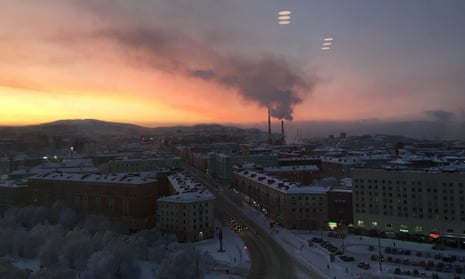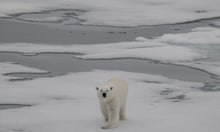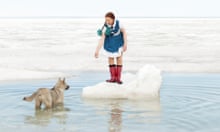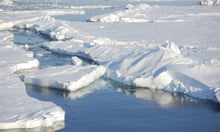It’s noon in Murmansk, but the sky is dark. Chunky silhouettes can just be made out scurrying along Lenin Street, swaddled in furs. This is a polar night, and it will be more than a month before anyone here sees the sun again.
When the Soviet Union collapsed, this city – by far the world’s largest settlement within the Arctic Circle – went into steep decline, its population tumbling from nearly half a million to barely 300,000.
Now, however, many here are anticipating a renaissance, driven by the Kremlin’s belief in the strategic importance of the Arctic, and melting Arctic ice caused by global warming.
The principal hope revolves around the northern sea route, a passage through the Russian Arctic from Murmansk in the west to Kamchatka in the east. West to east journeys are one-third shorter via this transit route than through the Suez Canal. It will also be used to transport the vast oil and gas resources in the Russian Arctic to internal and international markets. Currently a nuclear icebreaker is needed to accompany vessels travelling along the route, but as the ice melts – and it’s melting fast – that could change.
“We have all the conditions here to become a major international hub,” said Vasily Osin, the region’s acting transport minister. He said a major project to renovate Murmansk’s port would be completed in the coming years, and Moscow has announced a programme to construct or renovate 10 ports in the Russian Arctic in order to facilitate a revival of the northern sea route.
Murmansk was founded in 1916 in the twilight of the tsarist empire, and was developed as the Soviet gateway to the Arctic, mainly due to the year-round ice-free port. The frigid temperatures that would be expected at this latitude are tempered somewhat by the last whispers of the Gulf Stream, and the city has always experienced unpredictable weather – it can rain in January and snow in July. This had led many locals to be sceptical of global warming as a phenomenon – indeed many dismiss it as a western myth.
But there is no doubt that something is changing. Satellite pictures show record low ice levels, and navigation is becoming possible for longer periods.
“Three years ago boats could only go out into the Kara Sea in the end of July, but this year it was in the middle of July,” said Maxim Belov, a member of the regional parliament and the chair of its economics committee.
Belov, 35, is a fourth-generation Murmansk resident, innately hardy to the conditions dictated by the latitude. He dreams of a time when an Arctic region of newly built ports might assure easy passage for thousands of transit ships.
“Of course, it’s a matter of 10 to 15 years away, but the more shipping companies realise that there are these big savings to be made, maybe they’ll think it doesn’t cost that much more to equip their vessels to make them ice-class.”
For now, traffic on the route is a trickle – a fraction of the levels at the end of the Soviet Union. In 2011, Putin gave the northern sea route his backing, predicting that with time it would become “an international transport artery that will rival traditional trade lanes in service fees, security and quality”.
Putin has also stepped up Russian military activity in the Arctic, renovating a series of Soviet-era military bases in the region.
Now Russia is building new icebreakers, the first of which, the Arktika, will come online next year and at 173 metres long will be the biggest in the world and capable of tackling ice up to three metres thick.
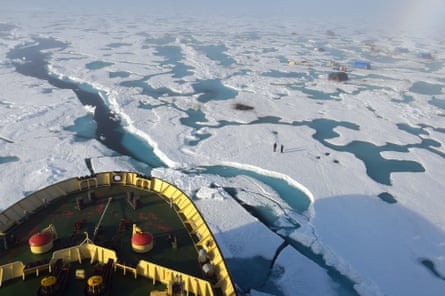
The warming Arctic should also theoretically improve conditions for oil and gas exploration, though here both the economics and ethics are on shakier ground.
In the short term, with falling oil prices and US sanctions on Russia, many of the difficult-to-access Arctic resources have begun to look less attractive in the past few years.
For years, the Shtokman gas field, one of the world’s biggest, was seen as the potential future driver of the region’s growth. Norway’s Statoil dropped out of the project in 2013 and French Total followed suit last year. Shtokman is one of the largest gas deposits in the world, but accessing it in Arctic conditions requires technological breakthroughs and appears unlikely to be profitable any time in the near future.
Currently the largest scale natural resource project in the Russian Arctic is a liquefied natural gas plant at Sabetta, in the estuary of the Ob river. It is due to come online next year, with gas shipments going along the northern route to Europe.
But ice melt has prompted warnings from environmentalists about the perils of prospecting for hydrocarbons in the Arctic. Vadim Krasnopolsky, oil and gas projects coordinator at WWF, says that global warming and reduced polar ice may not be entirely positive news for shipping in the area.
“For the next decades, there’ll definitely be ice in the Arctic, and even if the ice melts more, this can lead to moving ice sheets, and icebergs. Also, in the last decade, the number of dangerous weather situations doubled. Even if the temperatures warm up, it’s still the Arctic,” he said.

Life in Murmansk is not easy. In common with the Soviet-subsidised economy, Russian law provides benefits for those people who live in the far north, to compensate for the hardships of climate and latitude. State workers are paid significantly more than their counterparts in other parts of Russia. Statutory holiday days are also higher, and every resident receives a free return plane ticket once every two years to take a holiday somewhere warmer within Russia’s borders.
In summer, the town experiences a polar day of nearly two months, during which the sun never sets, while in winter, a polar night lasts 40 days. On clear days at both ends of the 40-day polar night, there is at least a three-hour period when the sun lurks just below the horizon, in which orange streaks light up the sky and the snowy cityscape gently glows with an ethereal pinkish hue. On overcast days closer to the winter solstice, there is merely an hour or two of grimy twilight around one in the afternoon.Some in Murmansk say polar nights are a breeze compared with a polar day, when the round-the-clock sunshine leads the body to produce endless stocks of serotonin, leading to insomnia and burnout.
But for all the climatic difficulties, Murmansk is a place to which its residents grow strangely attached, and as in other parts of the extreme Russian north, people display a warmth and friendliness not always seen in other parts of the country.
“We don’t have sunshine, so we have to warm each other up with smiles,” said Irina Ryabakova, a teacher.

During the oil boom of the first Putin decade wealthtrickled down to cities such as Murmansk. While much of the city’s housing stock has been battered by time and climate, there are new shopping malls and multiplex cinemas, and a brand new philharmonic hall opened in November. High-concept restaurants serve Arctic treats including grilled reindeer tongue and ice-cream made with local seaweed. And while many people are keen to leave Murmansk, they often end up returning.
“I wanted to leave, I even bought a flat in Voronezh [in central Russia], but then I spent some time there, and realised the people are so different, and decided I couldn’t leave here,” said Marina Myzheritskaya, a Murmansk-based psychologist.
The odds might be stacked against Murmansk, but Russia has an almost visceral attraction to the Arctic and a desire to resurrect the area economically and militarily, whatever the costs. A monument to “the conquerors of the Arctic” in central Murmansk takes in a range of dates, from Vitus Bering’s great northern expedition from 1733-1742, through Valery Chkalov’s solo flight over the north pole in 1937, to Artur Chilingarov’s 2007 north pole mission, during which the Russian flag was demonstratively placed on the seabed under the pole.
“I love the Arctic and I believe in the Arctic,” said Belov. “We have to make sure life in Murmansk flourishes.”
